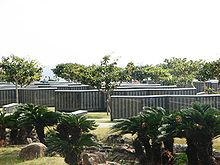Cornerstone of peace
The foundation of peace ( Jap. 平和の礎 , Heiwa no Ishiji) is in Itoman on Okinawa built monument . Together with the Okinawa Prefectural Peace Memorial Museum, it is intended to commemorate those killed in the events before and during the Battle of Okinawa . For this purpose, the memorial should serve as a place of remembrance of the losses of the war, as a place of prayer for eternal peace and as a place of meditation, as well as the transmission of the lessons of the war.
history
The memorial was unveiled on June 23, 1995, the 50th anniversary of the end of the Battle of Okinawa. The location chosen was the site of heavy fighting at the end of the battle near the former headquarters of the Japanese forces on Mabuni Hill (Hill 89). It lies within the Okinawa Senseki Quasi-National Park .
According to the then governor of Okinawa, Masahide Ōta , the name was chosen as a reference to the cooperation and security between Japan and the United States. Masahide later wrote in his book "Okinawa: Heiwa no Ishiji" that he hoped a place of remembrance and learning would help ease tensions over the US military presence on the island. In 2000, US President Bill Clinton visited the memorial. In a speech he confirmed the intention to reduce the military personnel on Okinawa.
Foundation stones and inscriptions
After a competition, the concept "Everlasting Waves of Peace" was chosen as the design. It consists of 116 wave-shaped arrangement of granite - steles . The names of those killed in the Battle of Okinawa, regardless of their origin and whether civilian or soldier, were engraved on these. The names of those killed can be found in the language of their home country.
The names of the following dead can be found:
- People who perished in events before and during the Battle of Okinawa. The period of stationing the 32nd Japanese Army on Okinawa (March 22, 1944 to March 25, 1945) was chosen.
- People who were killed in the Battle of Okinawa between March 26, 1945 and September 7, 1945.
- People who were killed by war-related events between September 7, 1945 and September 7, 1946.
- Okinawa residents killed throughout the Pacific War . The period from the Mukden incident to the surrender of Japan was chosen as the period
At the time of the unveiling, 234,183 names were to be found on the memorial stones. As more names are added each year, the number has grown to over 241,000. Including 140,000 residents of Okinawa, 77,000 residents of the other prefectures of Japan, 14,000 Americans and 82 residents of the United Kingdom .
A study by the University of California created a visualization of the memorial and the events of the battle using photographs from the archives of the Department of Defense .
Web links
- Map and pictures of the memorial (Japanese)
See also
swell
- ^ "Peace Memorial Park" , accessed November 25, 2018
- ↑ a b "The Okinawa Peace Memorial Park Project" , accessed November 25, 2018
- ↑ a b c Julia Yonetani: "Peace Wars: The Politics of Presenting the Past in Contemporary Okinawa" , accessed on November 25, 2018
- ↑ Marc Lacey: "Clinton Tries to Ease Anger At US Troops in Okinawa" , from www.nytimes.com on July 21, 2000, accessed on November 25, 2018
- ↑ "Names to be Inscribed" , accessed on November 26, 2018
Coordinates: 26 ° 5 ′ 42.7 " N , 127 ° 43 ′ 30.1" E
